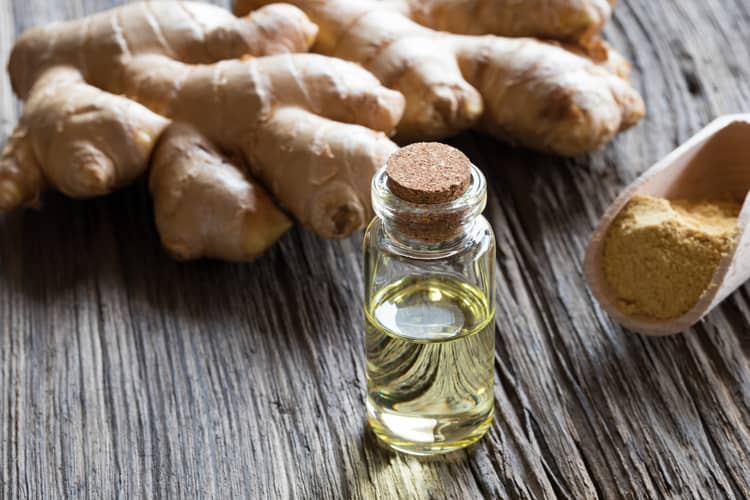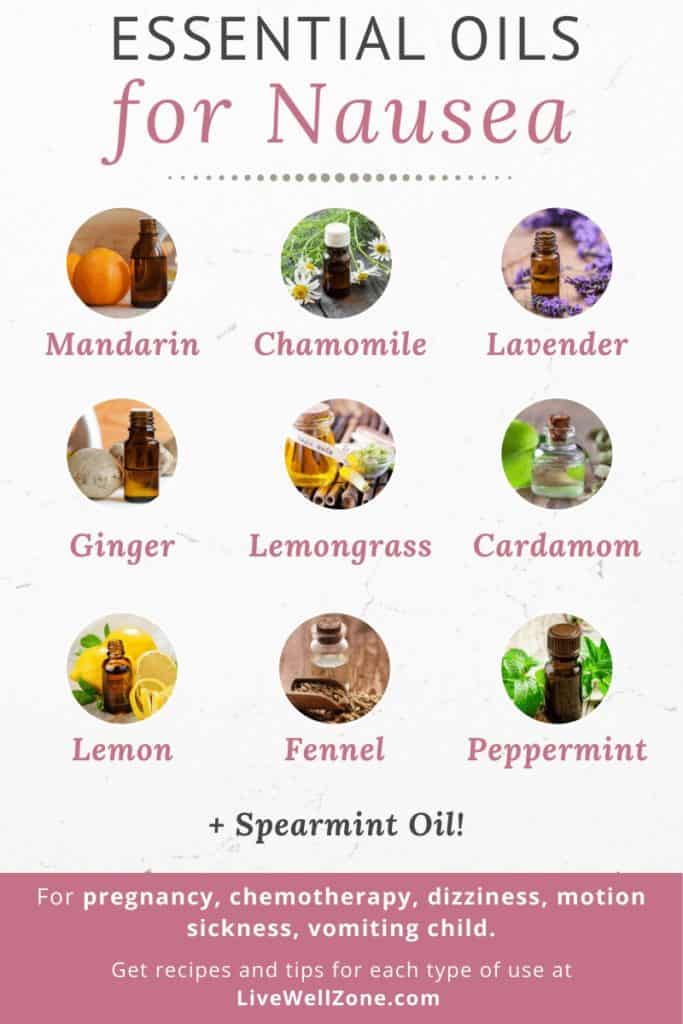
Whether you’re experiencing nausea from motion sickness, pregnancy, your period or other causes, there are essential oils for nausea and vomiting that are proven to give rapid relief.
This article gives you the top 10 essential oils you can use to stop nausea, how to use them for general nausea, as well as:
- Pregnancy nausea
- Chemotherapy nausea
- Dizziness and nausea
- Diarrhea and nausea
- Motion sickness
- Vomiting child
Now, let’s go ahead and dive into the essential oils you can use to treat nausea.
10 BEST ESSENTIAL OILS FOR NAUSEA RELIEF
The top 10 essential oils that help get rid of nausea and vomiting fast are:
- lemon oil
- peppermint oil
- ginger oil
- fennel oil
- lavender oil
- spearmint oil
- cardamom oil
- mandarin oil
- lemongrass oil
- roman chamomile oil
1. Lemon Oil
Morning sickness is a common form of nausea that many pregnant women experience.
And a 2014 study showed that lemon oil provides significant relief from morning sickness.
In that study 100 pregnant women who were experiencing nausea and vomiting were divided into 2 groups.
Group A placed 2 drops of lemon oil (diluted in almond oil) onto a cotton ball and inhaled it.
As for group B, they inhaled almond oil only (also placed on a cotton ball).
Both groups tracked their symptoms for 4 days.
Ultimately, the results showed that the lemon oil group had statistically significant improvements in nausea and vomiting (particularly on days two and four).
2. Peppermint Oil
Historically, peppermint leaf has been used as a digestive aid.
So, it’s no surprise that peppermint oil is also effective at reducing nausea and vomiting, especially in people recovering from surgeries.
In fact, a 2013 study showed that within 24 hours of using peppermint oil, chemotherapy patients experienced a reduction in the intensity and frequency of vomiting.
And as a side bonus, the use of peppermint oil also lowered the overall treatment cost for those chemotherapy patients.
In addition, peppermint oil has also been shown to help with nausea and diarrhea in people who have diarrhea predominant IBS (irritable bowel syndrome).
These results came from a 2013 study where 74 IBS patients used peppermint oil 3 times a day.
After six weeks, the study found that peppermint reduced their abdominal pain.
3. Ginger Oil

Just like peppermint leaf, ginger has historically been used to treat digestive issues.
And recent studies show that ginger oil is effective at reducing nausea.
For example, a 2017 study found that patients who had undergone abdominal surgery had less nausea and vomiting within 6 hours of inhaling ginger oil.
Meanwhile, a review of multiple essential oil studies concluded that ginger oil has repeatedly been shown to be effective at decreasing nausea.
Furthermore, a 2019 study comparing the effectiveness of ginger, lavender and rose oil on nausea, showed that 65.2% of those treated with ginger felt better within 15 minutes.
4. Fennel Oil
When it comes to digestive issues, fennel oil is a powerhouse.
Not only is fennel an effective natural remedy for nausea, but it also improves issues related to nausea (such as bloating, heartburn, gas, loss of appetite and constipation).
5. Lavender Oil
Lavender oil is most famous for its calming effects on the mind.
This means that if your nausea is caused by stress or anxiety, you could benefit from using lavender.
But what if your nausea is due to physical pain, such as surgery?
Well, a 2019 study shows that lavender oil can also treat nausea,
In the study, 184 patients who had undergone surgery received aromatherapy treatment with either lavender, ginger or rose oil.
The results showed that lavender was the most effective, with 82.6% of those treated with lavender oil reporting improved nausea scores after just 15 minutes.
6. Spearmint Oil
As a member of the mint family, spearmint is similar to peppermint when it comes to soothing the digestive system.
In fact, research shows that patients who have undergone same-day surgery have a lower need for anti-nausea medication after inhaling an essential oil blend that contains spearmint oil.
7. Cardamon Oil

Cardamom is popular Ayurvedic spice that happens to be in the same family as ginger.
And a 2013 study found that cardamom provides nausea relief for patient recovering from surgery.and anesthesia were broken in 3 groups.
In the study, the patient were split into three groups.
Group 1 inhaled a blend of cardamom, spearmint, peppermint and ginger oils.
Group 2 inhaled ginger oil only, while Group 3 inhaled isopropyl alcohol.
The group that inhaled the cardamom, mints and ginger blend had the most significant improvements in the intensity of nausea.
In addition, those who inhaled essential oils had a lower need for anti-nausea medication.
8. Mandarin Oil
Mandarin oil is great for inducing a sense of calm for the body and mind.
This characteristic was put to the test in a 2016 study were 10,000 patients at various Allina Health hospitals received aromatherapy (mostly via inhalation) as part of their care plan.
Various oils, including mandarin, lavender and sweet marjoram were used in the study.
The final results showed that mandarin oil not only helps with nausea, but it’s also beneficial for pain.
9. Lemongrass Oil
Next time you’re out shopping, pay attention to the teas and supplements for nausea.
You’ll notice that lemongrass usually features in ingredients list.
This is probably due to the fact that in folk medicine, lemongrass is a go-to remedy for digestive issues, including ulcers and stomach ache.
In addition, an animal study shows that lemongrass can prevent digestive issues like gastric ulcers.
Based on all this, it’s worth relying on lemongrass oil to stop nausea fast
10. Roman Chamomile Oil
Much like lavender, chamomile has soothing and relaxing properties that can help with nausea and upset stomach.
And one study has shown that chamomile oil (in a blend with aniseed, fennel and peppermint oil) provides nausea relief for hospice patients.
It’s important to note that in the study, the essential oils were used along with other treatments.
So, while we can’t attribute 100% of the improvements to the oils, they are a complementary therapy that provides benefits.

TIPS ON HOW TO USE ESSENTIAL OILS FOR NAUSEA

Some of the best ways to treat nausea with essential oils is through:
- inhalation
- diffusion
- self massage
- aromatherapy bath
Inhalation
To use essential oils via inhalation, you can:
- Inhale directly from the bottle for a few seconds at a time.
- Place 2 to 3 drops of essential oil on a cotton ball and inhale.
- Place 3 to 7 drops of essential in a bowl of very hot water and inhale the vapors.
In A Diffuser
Essential oil diffusion is an easy and convenient home remedy for nausea and upset stomach.
To diffuse essential oils, place 3 or more drops of oil into a diffuser. Then, run the diffuser for no more than 30 minutes at a time.
Massage Onto the Skin
When applying applying essential oils for nausea on the skin, always make sure to dilute them in a carrier oil
Start with a 2% or 3% dilution and if necessary, you can go up to a 5% dilution.
By the way, if you’re not familiar with dilution levels, this guide on how to dilute essential oils gives you a simple visual that you can use!
Some of the best carrier oils to use for dilution are coconut, almond, olive, jojoba and grapeseed oil.
NOTE: Lemongrass oil can irritate the skin and it’s best not to exceed 0.7% dilution for this oil. As for lemon oil, it makes the skin more photosensitive (as all citrus oils do). Therefore, you should avoid going out into the sun or using a tanning bed, immediately after applying lemon oil.
Add to A Bath
When nausea strikes, an aromatherapy bath can be just what you need to soothe the discomfort.
However, as with all essential oil uses, it’s important to follow specific safety guidelines:
- Do not add undiluted essential oils into your bath water. Otherwise you run the risk of severely irritating/burning the skin.
- Mix 5 – 20 drops of essential oils in 1 tablespoon of liquid carrier oil (jojoba or fractionated coconut oil are best in this case.). Add this to your bath water. While this doesn’t disperse the oils in the water, it dilutes them in the oil, which protects your skin.
- Another option is to mix 5 – 20 drops of essential oil in 1 tablespoon liquid castile soap. Add the mixture in your bath water. This eliminates the greasiness issue from the previous method and creates a more pleasant bath experience.
Note: avoid using lemongrass in a bath since it can irritate the skin.
HOW TO USE ESSENTIAL OILS FOR PREGNANCY NAUSEA

Of all the oils we’ve looked at in this post, the following are considered safe for pregnancy:
- Lemon
- Peppermint
- Ginger
- Lavender
- Spearmint
- Cardamom
- Roman chamomile
- Mandarin
When using essential oils while pregnant, make sure to:
- Use a 1% or less dilution.
- Never ingest the oils.
- Avoid using all skin-irritating oils.
Also, keep in mind that some experts recommend being extra cautious and avoiding all essential oils during the first trimester.
To learn more, read this post on essential oils and pregnancy.
HOW TO USE ESSENTIAL OILS FOR NAUSEA FROM CHEMOTHERAPY
As mentioned earlier in this article, peppermint oil has been shown to relieve chemotherapy-related nausea.
In addition, the Columbia University Irving Medical Center recommends using peppermint and ginger oils for chemotherapy nausea (source).
To benefit from these oils, you can diffuse or inhale them.
- For diffusion, use 3 drops each of peppermint and ginger oil.
- For inhalation, place 2 to 3 drops total onto a cotton ball and inhale.
ESSENTIAL OILS FOR NAUSEA AND DIZZINESS: TIPS AND RECIPES
A 2012 study analyzed the effects of an essential oil massage on painful period symptoms such as nausea and dizziness.
The study compared ginger and peppermint oils. The results showed that ginger oil is far more effective at reducing nausea that is accompanied by dizziness.
Ginger Oil Recipe for Nausea and Dizziness
Note: this blend uses a 2% dilution.
- 18 drops ginger oil
- Almond oil
- 1 ounce glass bottle
- Fill the glass bottle most of the way with almond oil.
- Add in the ginger oil.
- Seal and shake to blend.
- Massage onto the upper chest, neck and temples.
Ginger Oil Inhalation For Dizziness
You can also place 4 drops of ginger oil in a bowl of very hot water and then inhale the vapors.
Ginger Oil Diffusion For Nausea and Dizziness
If you’d rather diffuse ginger oil for dizziness, place 4 drops of ginger oil in your diffuser.
HOW TO USE ESSENTIAL OILS FOR NAUSEA AND DIARRHEA
As we saw earlier, one study found that peppermint oil provides relief from nausea and diarrhea.
Although the study states that the participants used peppermint oil 3 times a day, they don’t specify if inhalation or massage was used.
That said, if you’d like to see if peppermint helps with your nausea and diarrhea, you can either:
- Diffuse 4 drops of peppermint oil.
- Blend 9 drops peppermint oil with 1 tablespoon almond oil (or another carrier oil of your choice). Massage the blend onto the abdominal area.
TIPS ON USING ESSENTIAL OILS FOR MOTION SICKNESS
Ginger, peppermint and fennel oils are great natural remedies for motion sickness.
Here are some ways to use these essential oils as home remedies for motion sickness.
Essential Oil Roller Recipe For Motion Sickness
Note: this recipes uses a 2% dilution
- 2 drops ginger oil
- 2 drops peppermint oil
- 2 drops fennel oil
- Almond oil (or any other liquid carrier oil of your choice)
- 10 ml roller bottle
- Fill roller bottle almost all the way with almond oil.
- Add in the essential oils.
- Seal and shake well to blend.
- Apply to abdominal area and gently massage in for relief
ESSENTIAL OILS FOR A VOMITING CHILD

Before using essential oils on or around children, always make sure that the oils are kid-safe.
When it comes to essential oils for a vomiting child, roman chamomile and lavender are gentle enough for the little ones (including babies).
Here are the dilution guidelines for kids (source):
- 0 – 3 months: 0.2% dilution or less
- 3 – 24 months: 0.25 – 0.5% dilution
- 2-6 years: 1 – 2% dilution
- 6 – 15 years: 1.5 – 3%
CONCLUSION
If you’re struggling with nausea and you want a fast, natural remedy, then definitely give essential oils a try.
Do keep in mind that the recipes and tips in this post are meant to be a general guide.
In order to really benefit from essential oils, it’s important that you actually enjoy the aroma of the oil(s).
So, if one of the oils in this list doesn’t appeal to you, try another one.
When you actually enjoy the aroma, that increases the relaxing sensations your body needs to respond positively to the oil.
And if you have any questions or feedback on essential oils for nausea, I’d love to hear from.
Feel free to drop a comment below 🙂
Related Posts:
How to Dilute Essential Oils: A Simple Essential Oil Dilution Guide and Chart
18 Essential Oils For Sore Throat: How to Use and Easy Recipes
Essential Oils for Hormone Support: Top Oils to Use, How to Use and Blends for Relief
4 Powerful Essential Oils For Pain and Inflammation


